The emerald ash borer may get the most headlines, but a host of diseases and pests can infect, wither, and kill your favorite ash trees. Knowing the symptoms of ash tree diseases can help you spot any problems and know how to treat them.
The goal of this article is to help you identify the disease before that fungus or pathogen kills your ash tree or leaves you no option but to cut it down. As a bonus, we’ll talk about three common pests that attack ash trees. When you’re finished reading, you’ll know the difference between the emerald ash borer and the banded ash borer.
Here are seven of the most common ash tree diseases (and three bonus ash tree pests). For each, we have highlighted the symptoms, causes, treatments, and risks of what may be infesting your ash tree:
Seeing your once vibrant ash tree’s leaves turn an alarming shade of brown can be puzzling and worrying for any tree owner. But don’t panic! Browning ash tree leaves are usually indicative of an underlying issue that when identified and addressed early can be resolved. In this article, we’ll explore the common reasons behind ash leaf browning, effective solutions to restore your tree’s health, and tips to prevent recurrence in the future.
Common Causes of Ash Tree Leaf Browning
There are several factors that can cause the leaves of your ash tree to turn brown
Water Stress
Improper watering, especially during hot, dry weather, is one of the most common reasons for leaf browning. Ash trees have extensive root systems and require a good amount of water. Insufficient water prevents the roots from absorbing enough moisture and nutrients to facilitate photosynthesis, resulting in browning leaves.
Nutrient Deficiency
Lack of vital nutrients like nitrogen, phosphorus, and magnesium in the soil leads to nutrient deficiency, impeding the tree’s growth and causing the leaves to brown. Nitrogen deficiency is particularly common, making the leaves turn completely brown or yellow before falling off.
Diseases
Fungal diseases like anthracnose or rust infections can cause light brown spots, patches, or irregular splotches on ash tree leaves. As the disease spreads, it blocks water and nutrient transport, leading to browning, curling, wilting, and leaf drop.
Pests
Sap-sucking insects like ash plant bugs can puncture the leaves and inject toxins that disrupt chlorophyll production and cause stippling, browning, and eventual leaf death. Borers and webworms chew holes in the leaves, destroying leaf tissue and also causing browning.
Other Causes
Improper soil pH, compacted soils, winter injury, storm or wind damage, pollution, and old age can also contribute to ash leaf browning.
Solutions to Treat and Prevent Ash Leaf Browning
If your ash tree’s leaves are turning brown, prompt action is key to nurses it back to health:
Ensure Proper Watering
Check soil moisture and water young trees weekly and mature trees every 2 weeks during dry spells to maintain optimal moisture. Deep watering is better than frequent shallow sprinkling.
Fertilize the Tree
A balanced, slow-release fertilizer provides nutrients for healthy growth. Have a soil test done to determine any deficiencies. Foliar sprays can provide an instant boost.
Rule Out or Treat Diseases
Inspect leaves and branches thoroughly for disease symptoms and treat promptly. Improve air circulation and leaf litter cleanup to prevent recurrence.
Eliminate Pest Infestations
Apply eco-friendly pesticides or insecticidal soaps to control sap-feeding bugs. Remove webbing, prune away borer-infected branches, and introduce beneficial predators to counter pests.
Evaluate Other Growing Conditions
Check for girdling roots, damaged bark, proper sunlight and air exposure, sufficient drainage, and damaged branches. Correct circumstances accordingly to alleviate stress.
Seek Professional Care
For persistent or recurring issues, consult a certified arborist for inspection, lab tests, proper diagnosis and customized treatment plans. Expert care goes a long way in saving distressed trees.
Prevention Is Better Than Cure
They say an ounce of prevention is worth a pound of cure. To avoid ash leaf browning in the future:
- Water deeply and consistently, especially during summer
- Mulch and amend soil with compost annually
- Fertilize in early spring and as needed
- Prune judiciously for shape and airflow
- Monitor for pests and diseases regularly
- Protect from weather damage and injuries
With vigilant care and early intervention at the first signs of browning, you can ensure your ash tree stays healthily green for years to come!
When Should I Seek Professional Help?
It’s always a good idea to enlist professional expertise if:
- Browning persists despite your best efforts
- More than 30% of the foliage is affected
- You notice dying branches or canopy thinning
- You are unable to diagnose the cause
- The tree shows signs of structural weakness or decay
Reaching out to a certified arborist for evaluation and customised treatment can mean the difference between losing or saving your precious ash tree.
Final Thoughts
Brown leaves on your ash tree can be upsetting but are rarely fatal when the underlying causes are caught early. By understanding why it happens and taking appropriate corrective actions, most instances of ash leaf browning can be successfully resolved. Stay vigilant for early symptoms, provide attentive care, enlist expert help when required, and your ash tree can thrive for years to come.
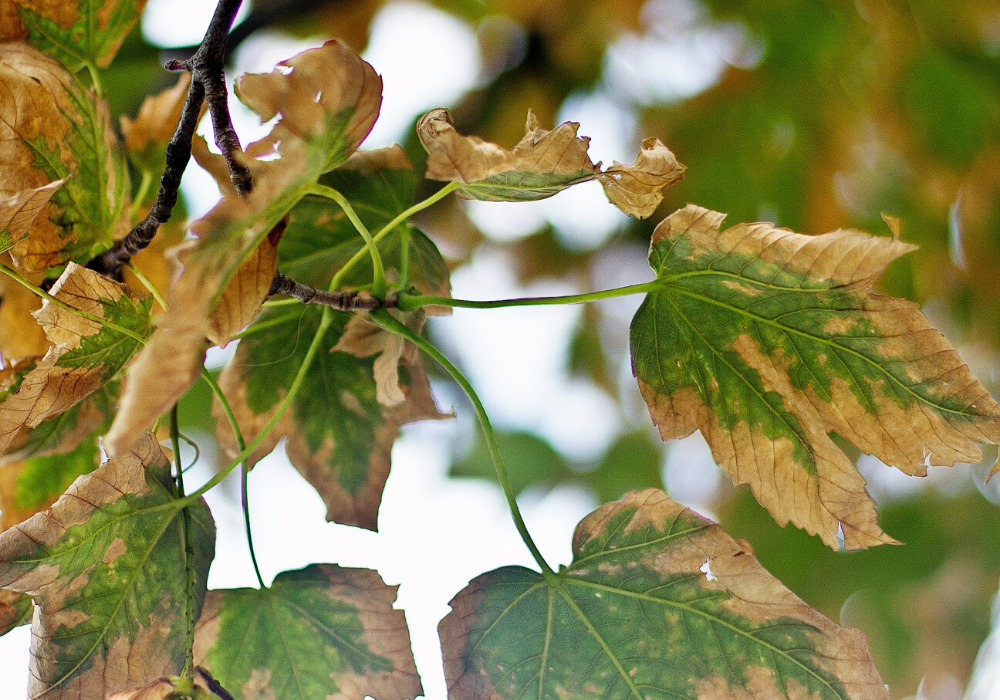
Cotton Root Rot
Trees affected: This fungal disease is also known as Phymatotrichum root rot, Texas root rot, and Ozonium root rot. The disease infects more than 2,000 species of plants and is one of the most challenging fungal diseases to control.
Symptoms:
- Symptoms begin with a slight yellowing or bronzing of the host’s leaves.
- After three days, permanent wilting occurs, followed by death.
- Trees and shrubs succumb to the disease more slowly.
- Affected areas appear as circular patterns of dead plants and can gradually enlarge over time.
Causes: Cotton root rot is caused by the fungus Phymatotrichopsis omnivorum. The fungus invades new areas by slow growth through the soil from plant to plant. The fungus can survive in the soil for many years and as far as 8 feet deep in the ground.
Treatment: Cotton root rot is one of the most difficult plant diseases to control. One solution is to plant a resistant grass crop around the infected area. The resistant crop creates a barrier that limits the spread of the disease.
If cotton root rot is infecting your ash tree, there is a chance of saving the tree if the decay is not yet substantial. Oklahoma State University recommends covering a ridge of soil around the tree’s drip line with a 2-inch layer of organic matter or cow manure. Then, scatter ammonium sulfate and sulfur over the manure.
Flood the basin with enough water to soak the soil to a depth of 3 feet. Keep the soil moist for several weeks after treatment. Your ash tree is likely to recover within the season.
Seasons: Symptoms usually occur from June through September when soil temperatures reach 82 degrees.
Risk Level: This fungal disease can survive in the soil for many years and kill even your biggest ash tree.
Ash Anthracnose Disease
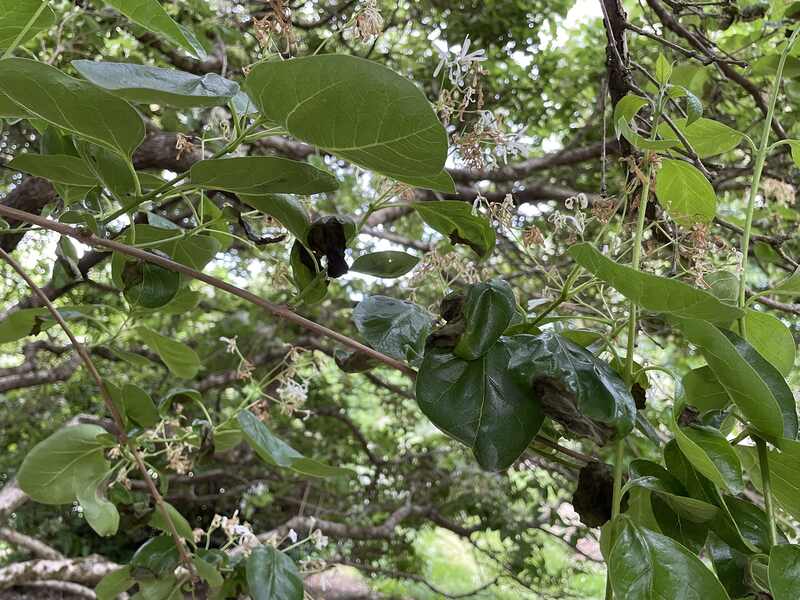
Trees affected: Ash anthracnose disease is especially common in green ash. Anthracnose is specific to the kind of tree it infects, so anthracnose of oak will not affect ash (Fraxinus spp.), and anthracnose of ash will not spread to any other type of tree besides ash. However, the symptoms and the management methods are the same for most anthracnose diseases of trees.
Symptoms:
- Leaves may develop large black or tan patches that cause the leaves to deform in those areas.
- Small purple-to-brown spots may also appear in the middle of the leaves.
- In severe cases, complete defoliation may occur.
- Symptoms typically first occur on the lower and inner canopy leaves.
Causes: The fungus that causes ash anthracnose, Gnomoniella fraxini, overwinters in the upper parts of trees in seed samara or on twig cankers. Spores form in tiny fruiting bodies and begin infection around the time the ash leaves are budding out. Spores are spread by wind and splashing rains to infect buds, twigs, and newly emerging leaves.
Season: Infection occurs in the spring and prefers wet, cool weather.
Treatment: Prune affected branches. In autumn, dispose of all fallen leaves to help prevent any excess spores from reinfecting in the spring. Iowa State University does not recommend the use of fungicides since anthracnose is rarely a severe problem in ash trees.
Risk: Ash anthracnose disease is rarely a concern for healthy mature trees unless it is severe for many consecutive years. If the tree experiences multiple reinfections, it may weaken and become vulnerable to other diseases and pests.
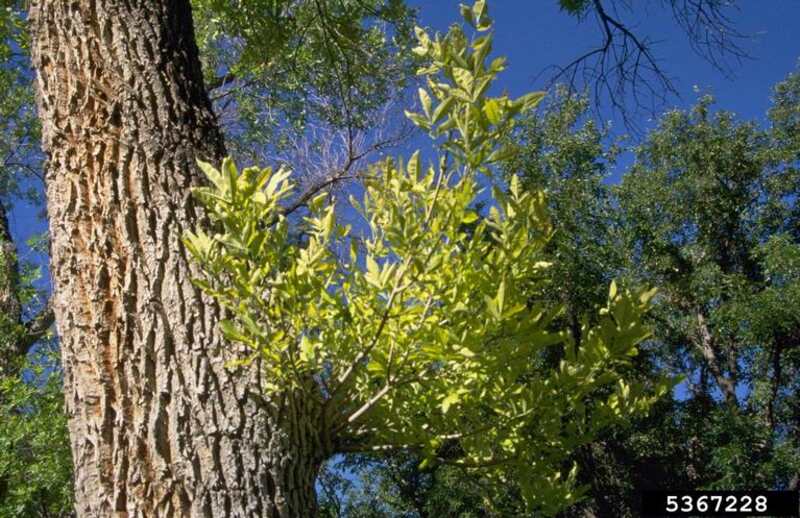
Trees affected: White ash is particularly susceptible to ash yellows, also known as ash decline. Ash yellows is also a common Arizona ash tree problem.
Symptoms: Ash yellows disease affects trees of all ages, and the following symptoms usually occur within three years of infection:
- Leaves may appear smaller, thinner, and lighter green.
- Trees will occasionally grow branches in tufts.
- Infected trees may grow at a much slower rate than non-infected trees, typically reaching about half the height of a healthy tree.
Causes: Ash decline is caused by the phytoplasma Candidatus Phytoplasma fraxinii, a bacteria-like organism. The phytoplasmas live and survive in the food-conducting tissue of the infected plant. There is no definitive cause of ash yellows, but leafhoppers may be the primary means by which the phytoplasmas spread from tree to tree.
Treatment: There is no known cure for this ash tree disease. Remove any infested trees immediately to prevent the spread of phytoplasma to healthy trees. According to the University of Wisconsin-Madison, wood from infected trees can be used as firewood or chipped for mulch.
Risk: Some infected trees may live and grow slowly with ash yellows for many years. Infected trees eventually experience branch dieback, gradually leading to tree death.
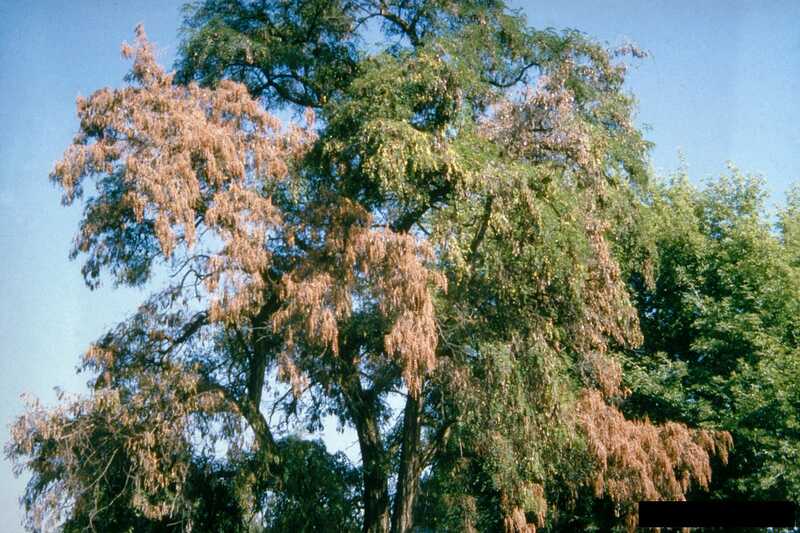
Trees affected: Verticillium wilt is a fungal disease that affects over 300 species of plants.
Symptoms:
- Leaf edges turn yellow, then brown and dry.
- Sudden wilting on one or several branches may occur. It’s often only one side of the tree that wilts.
- The wood underneath the bark of drooping branches often has discolored streaks. You may notice the wood’s discoloration after pruning.
Causes: Trees under stress from drought, nutrients, or salt are more likely to experience Verticillium wilt. The soil-borne fungus Verticillium albo-atrum causes Verticillium wilt.
Infection occurs in the root system, where the fungus produces resting structures that can survive in the soil for many years. The fungi that grow from these structures may penetrate the roots and cause water movement within the tree to suffer.
Season: Symptoms occur in midsummer.
Treatment: Since the fungus can live for a long time underground, it’s best to plant resistant trees in the contaminated soil. To delay the progression of Verticillium wilt, prune affected limbs and provide your tree with adequate water and fertilizer.
Risk: Verticillium wilt may kill your ash tree in a single season. Your ash tree may also survive for many seasons, with each branch slowly dying.
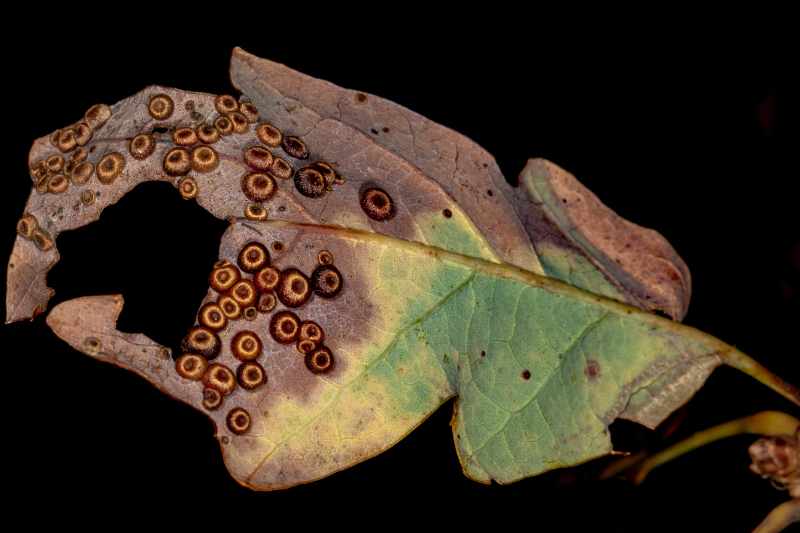
Trees affected: Susceptible ash trees include white, green, and black ash.
Symptoms:
- Small yellow or yellow-orange spots appear on the upper leaf surfaces.
- About 10 days later, bright orange-yellow clusters of spore-producing structures (aecia) develop underneath the leaf.
- Leaves may become distorted.
Twigs and stalks joining the leaf and stem (petioles) may develop wart-like swellings. These swellings will also form the clusters of aecia. Leaf tissue will begin to die, and some trees may appear scorched. Heavily infected trees may experience defoliation.
Cause: The ash rust fungus (Puccinia fraxinata) has five spore stages, two of which occur on an alternate host (marsh and cord grasses). In the spring, teliospores infect the tissues of ash, which then develop spermogonia and aecia. The aecia produce aeciospores, which the wind then blows to either alternate hosts.
Uredinia then form on the new hosts in early summer and produce urediniospores, which repeatedly infect cord and marsh grass. The uredinia will develop into brownish-black telia structures that produce teliospores. These teliospores then infect the ash trees the following spring.
Season: Symptoms may first appear in mid-May.
Treatment: The University of Delaware recommends applying Systhane WSP (myclobutanil) or Immunox. Fungicides may only act as a preventative measure and will not be an effective control method once your ash tree has been infected.
The Cooperative Extension suggests applying the fungicide two or three times around the time leaves start to expand. Then once or twice again at 10-day or two-week intervals.
Risk: Ash rust rarely kills trees.

Trees affected: Powdery mildew can affect many trees. The most common include ash, lilac maple, dogwood, magnolia, basswood, crabapple, catalpa, and oak.
Symptoms:
- The fungi produce microscopic chains of spores that give the infected areas a white powdery appearance (upper and lower leaf surfaces, young stems, shoot tips, blossoms, and flower buds).
- The Infection may cause leaf yellowing, browning, distortion, or premature leaf drop.
Cause: A closely related group of fungi causes powdery mildew. The powdery mildew fungi overwinters inside infected buds. When the buds open in spring, they become covered with powdery spores, which the wind then carries to infect new leaves, fruit, and shoots.
Treatment: Plant susceptible trees in areas with adequate sunlight and good air circulation to reduce moisture. You may prune your plants to ensure air circulation. You can treat powdery mildew with a registered fungicide, which may also help to control the disease.
Risk: Powdery mildew is rarely lethal. Young ash trees growing in heavily shaded areas are the most affected by this disease.
Note: Powdery mildew can also affect your lawn. You can treat powdery mildew on your lawn with lawn fungicides and prevent the condition with cultural practices such as reseeding shady spots, watering properly, and mowing at the proper height.
Problems on ash tree leaves |Daphne Richards |Central Texas Gardener
FAQ
Why is my ash turning brown?
How to treat brown spots on ash tree leaves?
Ash rust weakens the tree by affecting leaf function and causing defoliation. Prevention and Treatment: – Fungicides: Apply fungicides to control rust outbreaks during the growing season. – Leaf Removal and Pruning: Remove and destroy affected leaves to minimize disease spread.
Can a tree with brown leaves recover?
Leaf scorch is not curable or reversible; however, a tree can recover and begin producing new, healthy foliage if proper care is taken.May 19, 2022
Can a dying ash tree be saved?
In many cases, yes. Ash conservation efforts are stronger than ever, and treatment options are available to protect trees.May 24, 2022
